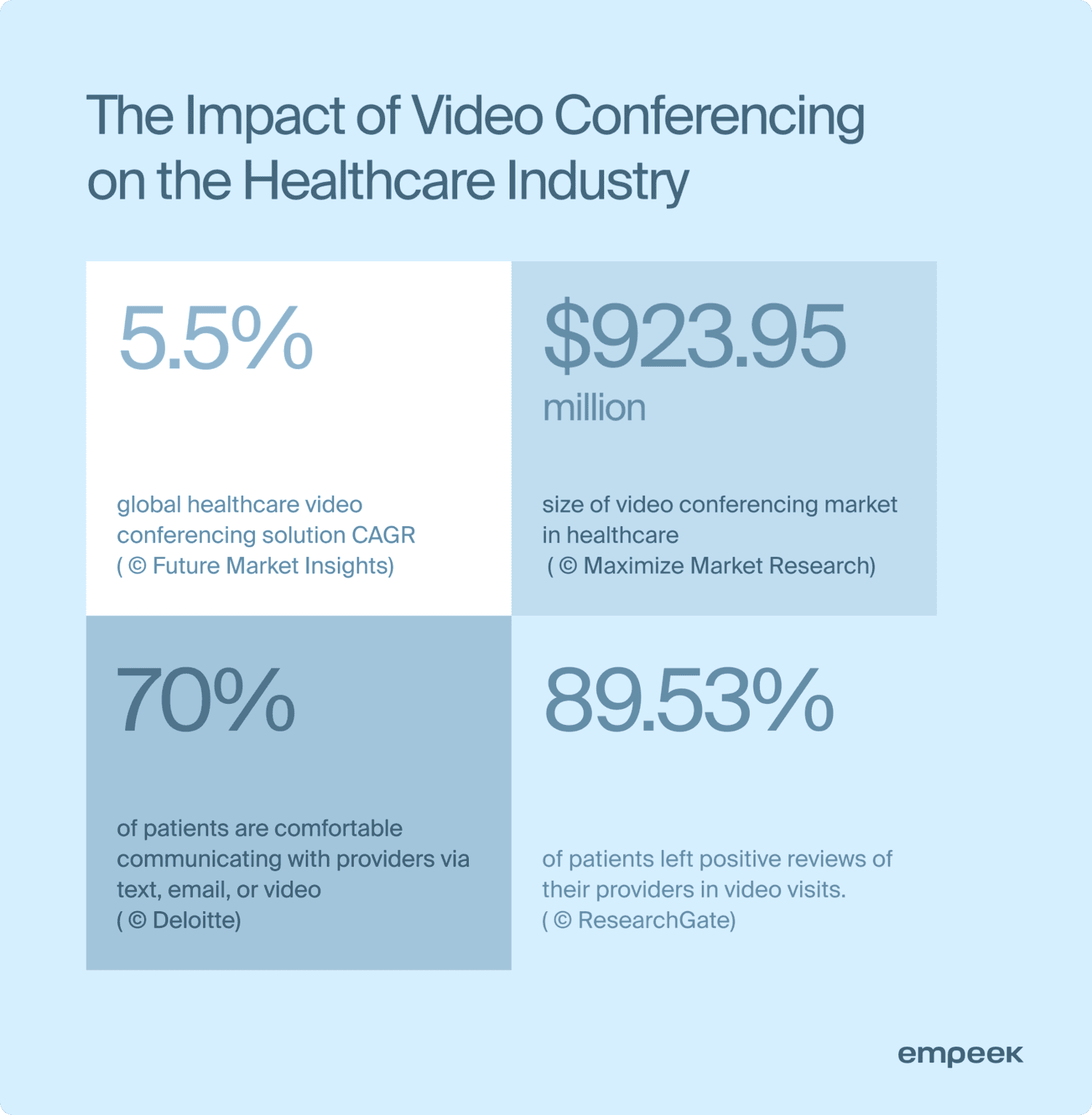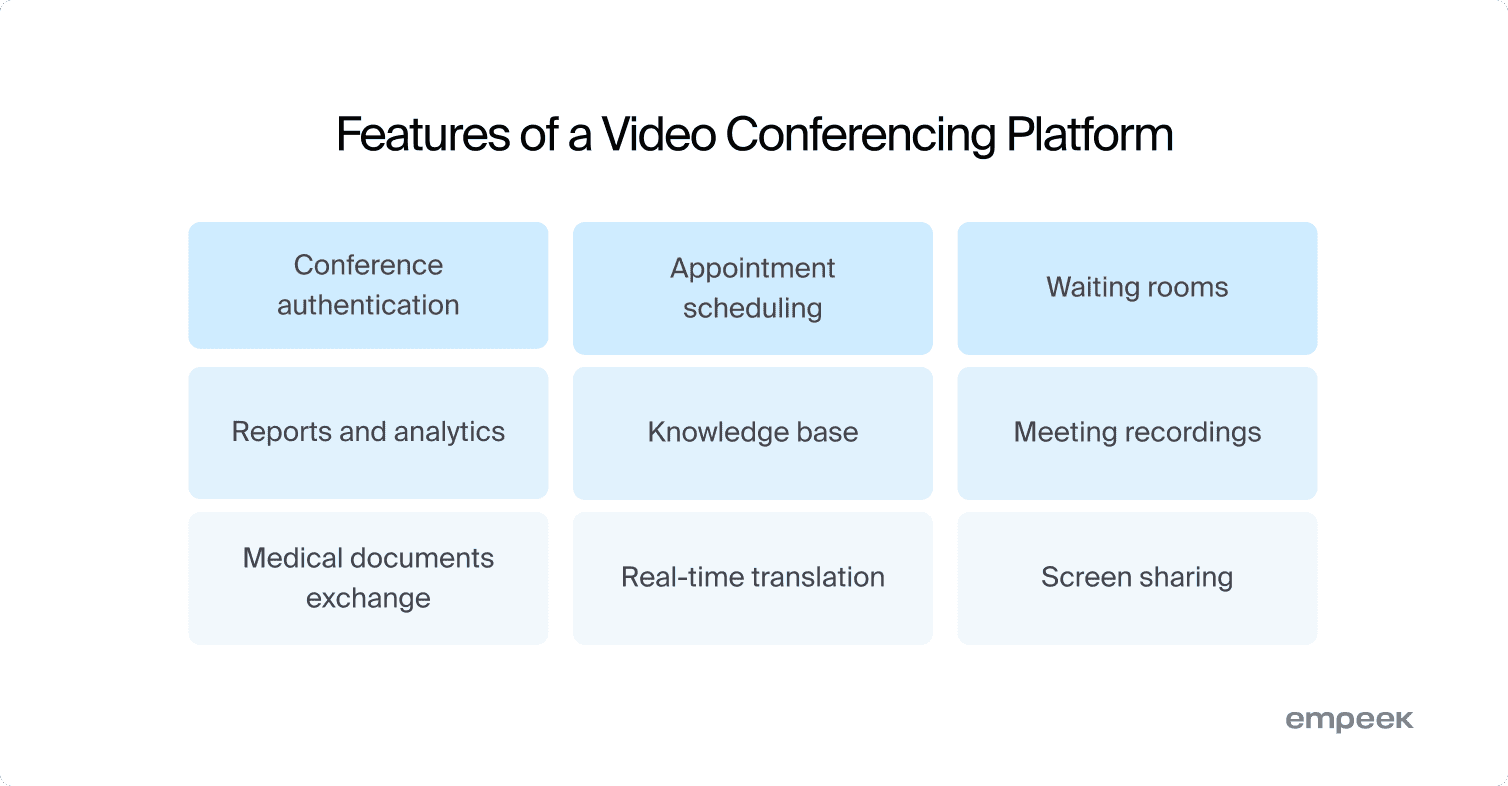Telehealth video conferences effectively improve the quality of healthcare services and enable timely medical care. Digitalization of physician-patient interactions provides remoteness, efficiency, and convenience both for clinicians and patients anytime and anywhere.
Learn more about the advantages of video telehealth monitoring, the core functionality of video monitoring solutions, and examples of successful usage of video conferencing solutions in our article.
Importance of Using Doctor Video Conferences in the Healthcare System
Video conferencing, as a part of the general telemedicine model, is an online video interaction between patients and physicians using specialized telehealth software. Together with other telehealth solutions such as chats and phone calls, this technology creates virtual spaces for remote patient diagnostics, monitoring, and treatment.
Telemedicine and medical video conferencing solutions gained momentum in 2020 during the COVID-19 outbreak. Video calls have become indispensable for organizations across multiple fields, and healthcare is no exception. Even though the pandemic has ended, experts predict the video conferencing market will keep snowballing in the upcoming years, reaching almost $923.95m by 2029.

Video conferencing telehealth is particularly important for those who require ongoing monitoring and control, like high-risk patients who suffer from chronic diseases. Video conferencing in healthcare solutions is a game-changer for such patients as it reduces the time and effort spent to get to the hospital and eliminates the need to wait hours for an appointment.

With all these benefits achieved, it is no wonder state hospitals, nursing centers, and other medical institutions worldwide are upgrading their means of communication by implementing telehealth video conferencing. This strategic step helps them keep a competitive edge, deliver healthcare services for more patients, improve the quality of care, and increase ROI.
Video Conferencing for Monitoring the Patient: How it Works
Video conference doctor technology is a solution serving as a point of contact between a medical specialist and a patient. Doctors can join a prearranged video call with a patient through a specialized platform. Depending on the software settings, the meetings can be scheduled by patients, physicians, doctor’s assistants, and/or administrators.
The process of using doctor video conferences includes the following steps:
- Accessing the system to schedule a visit using a computer, tablet, or smartphone.
- Selecting a free time slot and applying for an appointment.
- Providing personal information and configuring appointment reminders.
- Accepting the meeting in a digital calendar synced with the video conferencing platform.
- Accessing an appointment a few minutes before to check audio and camera.
Telehealth solutions vary widely, ranging from mass-market software to tailor-made apps embedded into the clinic’s website and IT infrastructure. Hence, you can adapt this workflow to a specific business need or end-user preferences. If you want a custom doctor video conference tool, hire a telemedicine software development provider. Healthcare engineering companies specialize in medical software and can create a personalized solution for your organization from scratch or help customize third-party software.
Key Aspects To Consider for Quality Video Consultations
Choosing the right software is critical while implementing a telemedicine service, as its functionality and capabilities directly affect the quality of care. However, there are a few other aspects you should take into account, like internet speed, convenient UI, and telehealth device interoperability. Even though these details are often neglected, they are no less crucial to making video conferences smooth and secure.
The Internet Speed
Conducting a high-quality video conferencing visit without interruptions is crucial for the proper functioning of the telehealth app. According to the guide for broadband speed developed by the Federal Communication Commission (FCC), high-definition video consultations require a minimum of 6 Mbps download speed. For Ultra HD 4K Video streaming, patients and doctors will require a minimum of 25 MB/s download speed and 3 MB/s upload speed. However, the requirements for connection speed may increase if more telehealth devices operate during a doctor video conference.
User-friendly Interface & intuitive UX
To ensure a high user adoption and satisfaction rate, you must thoroughly plan the app’s UI/UX design at the initial stage of app development. If you integrate an off-the-shelf solution, test its navigation flows and interface for any inconveniences before implementation.
For the elderly, a weighty advantage will be in the ease of use of video conferencing, for they may find it difficult to use a new technological solution. UI elements must be large and intuitive. You can also set up the app usage tutorial for first-time users to eliminate potential difficulties in navigation.
Interoperability
Without the app’s seamless integration into the existing digital infrastructure, its benefits will be limited. Real-time data exchange between video conferencing tools, EHR systems, IoT devices, and other software solutions you use is one of the most critical aspects you must consider and support with a proper strategy. Read more about interoperability and why it matters.
Key Features of Doctor Video Conference Solutions
Video conference doctor apps’ capabilities go far beyond mere video call scheduling since they practically need to replace all the services in-person appointments provide. The diversity of features allows providers to offer a full-fledged treatment using video conferencing solutions.To cover the most important healthcare processes, video conferencing apps support appointment scheduling, reports and analytics, knowledge base, meeting recordings, real-time translation, and medical document exchange functionality. Some advanced features may include automation, AI-powered data management, and IoT-based notifications.

Here is a complete list of the most common features of a video conferencing portal.
| Conference authentication | The app requires multi-factor authentication (MFA) when users enter a doctor video conference tool to avoid unauthorized access. Patients and physicians must prove their identities (passwords, fingerprints, specific codes, etc.) for data protection. |
| Regular visit appointment scheduling | The software has a technical opportunity to set up automatic follow-up video calls and schedule regular meetings for patients with chronic diseases or those requiring frequent monitoring and checkups. |
| Waiting rooms for patients | Doctors can see patients who joined the call and let them in. |
| Reports and analytics | Doctors can generate custom reports based on patient-relevant information: personal measurements, the history of calls, the list of appointments, billing info, and other details. |
| Knowledge base | Portal users can access various educational materials, tutorials, video training, FAQs, presentations, tests, etc. |
| Meeting recordings | Both patients and doctors can record the meeting to make sure not a single thing is missed during the conversation. And that’s a decisive advantage of videoconferencing compared to live meetings. |
| Exchange of medical documents | Medical specialists can share patient data, test results, and other medical documentation within the system. |
| Real-time translation feature | For patients who don’t speak English, the portal provides real-time captions in their native language. This feature prevents misunderstandings and helps patients receive necessary information without delays. |
| Screen sharing | High-resolution screen sharing enables physicians to show patients’ CT, X-ray, or MRI images, test results, protocols, and other medical documents without patients’ physical presence in the hospital. |
Most third-party telehealth video apps provide standard features as software providers aim to create universal multi-purpose solutions. Therefore, you may need custom-developed software to stand out on the market and offer unique functionality to patients and medical staff. With custom solutions, you can adjust doctor video conference apps to your needs and cover specific healthcare requirements like accessibility peculiarities. This way, the platform will align with specific medical practices and improve patient satisfaction.
6 Benefits of Using Video Conferencing in Healthcare
The popularity of virtual visits proves their strong benefits for both doctors and patients. Online doctor consultations significantly increased from 81.07 million users in 2020 to 116.73 million in 2024. This number is expected to reach 124.83 million in 2026 as more and more users switch to telehealth.

To help you identify gains from telehealth technology, we’ve prepared a detailed list of the advantages of video conferencing in telemedicine that you need to know.
1. Time-efficiency And Streamlined Delivery of Healthcare Services
Recent research has found that the video visit cycle takes 56 minutes less than clinic visits (24 minutes compared to 80 minutes). Patients no longer have to consider numerous factors such as hospital location, traffic, hospital queues, quarantine periods, and many others while scheduling a visit.
Virtual visits also allow for greater flexibility. When it comes to offline meetings, it may be hard to find a free time slot and arrange a meeting with a doctor. Besides, patients often postpone checkups and don’t monitor their health properly. Numerous visits are being canceled at the last minute, or patients do not show up. All these dramatic issues can be minimized or eliminated with the help of telehealth technology.
2. Accessibility And Patient-Centered Care
Many patients across the United States prefer telemedicine appointments — 53% of the survey respondents think they are more convenient than in-person visits. Moreover, 43% of telehealth users think virtual visits are faster than in-person checkups. This proves that telehealth solutions are a game-changer for patients, especially those in rural or remote areas.
Read about the Possibilities & Limitations of Rural Telemedicine
Video calls allow them to communicate with doctors without having to travel miles to reach the hospital. People can set up a call even for several minutes to do a regular checkup, confirm their health status, or get proper treatment instructions from a specialist. This enables patients to receive quick and effective healthcare no matter where they are. Besides that, patients feel more comfortable communicating with doctors being at home rather than at hospitals.
3. Cost Reduction for Both Patients And Clinicians
Telehealth video calls can save money for all stakeholders involved. Since 71% of ambulance visits aren’t covered by insurance, patients may need to pay more than $450 for an uncritical ER stay. Healthcare providers also cut expenses since telemedicine platforms reduce emergency visits and improve health plan budgets. Each telehealth visit that occurred instead of an ED visit saved from $309 to more than $1,500 for medical providers. Therefore, telehealth cheap costs for appointments allow both providers and patients to save significant sums.
Here are the main reasons why patients, doctors, and insurance companies win from video conferencing:
- Online visits are usually cheaper than in-person office or home visits;
- More video conferences can be scheduled a day, which means more treated patients and thus the revenue increase;
- No transportation expenses are required;
- No additional medical materials or other expenses related to patient visit;
- Unexpected/urgent visits or re-hospitalizations can be prevented;
- Video conferencing transforms on-call hours into billable.
4. Improved Healthcare Services
Healthcare quality improves with the use of telemedicine devices, as demonstrated by the experience of the Ochsner Health System. They applied telehealth solutions to provide timely acute care for patients with stroke. The company increased the number of video appointments by more than 100%, which mitigated the risks of patient state complications since stroke treatment is a time-sensitive matter. Thanks to the advantage of incorporating video conferencing into the practice, clients can use urgent real-time consultations and receive instructions as soon as possible. Besides, doctors can connect with other medical specialists via video call to receive additional expertise and points of view.
Digital solutions also help patients’ family members and caregivers receive quick advice in case of any doubts or unexpected symptoms. This enhances healthcare service quality, enables more timely interventions, prevents hospitalizations, and, in many cases, even saves lives.
5. Chronic Disease Management
Analyzing the effects of videoconferencing on patients with diabetes, obesity, and cardiovascular diseases, the researchers noticed better meditation adherence and dietary improvements. Patients switched to healthier food intake and improved their diet quality. Moreover, physicians managed patients’ blood pressure better with telehealth solutions.
Video conferencing tools boost chronic disease treatment as physicians can adjust the healthcare plan immediately. The doctors can schedule more follow-up appointments and check patients’ diet and medication results remotely since patients with chronic conditions can’t visit physicians’ offices frequently. Video appointments enable regular explanation of imaging, tests, and symptoms so that patients always keep up with the course of treatment. Also, a telehealth subscription allows them to receive fitness advice and ask any questions when needed.
6. Increase in Patients’ Health Awareness
With video conferencing apps, patients can access and discuss their laboratory tests and doctors’ notes as soon as they are ready. This way, patients become active participants in their treatment since the availability of results raises awareness about their current medical condition. Easier access to healthcare and regular video appointments allows patients to follow a clear personal plan and be more involved in the treatment process. The doctors, in turn, can promote and implement preventive medicine strategies to reduce disease risks.
That’s how doctor video conferences benefit patients and providers by facilitating service delivery, increasing accessibility, reducing treatment costs, improving healthcare quality, enhancing chronic illness control, and engaging patients in their treatment. Video conferencing tools make physicians and patients better connected through easily planned calls and regular follow-ups.
You may also be interested in How to Create a HIPAA Compliant Telemedicine Platform
Final Thoughts
Video conferencing in healthcare cannot fully substitute in-person room meetings with doctors. But this digital solution is perfect for cheap telehealth visits, regular checkups, patients in remote locations, preventive consultations, and many other uses. Implementation of telehealth software improves appointment management, reduces patient no-shows, enables medical training, facilitates reporting, and streamlines healthcare operations. As a result, clients receive high-quality medical services, and providers can operate more efficiently.
If you want a custom video conferencing solution, Empeek‘s team can assist you with software development, implementation, and maintenance. We build digital healthcare solutions for various domains, including home care, pharmaceutical, dental, mental health, veterinary, and rehabilitation. Contact us to learn how we can help you adopt video conferencing for telehealth.








